engine Citroen BERLINGO MULTISPACE 2016 2.G Owner's Guide
[x] Cancel search | Manufacturer: CITROEN, Model Year: 2016, Model line: BERLINGO MULTISPACE, Model: Citroen BERLINGO MULTISPACE 2016 2.GPages: 296, PDF Size: 10.36 MB
Page 150 of 296
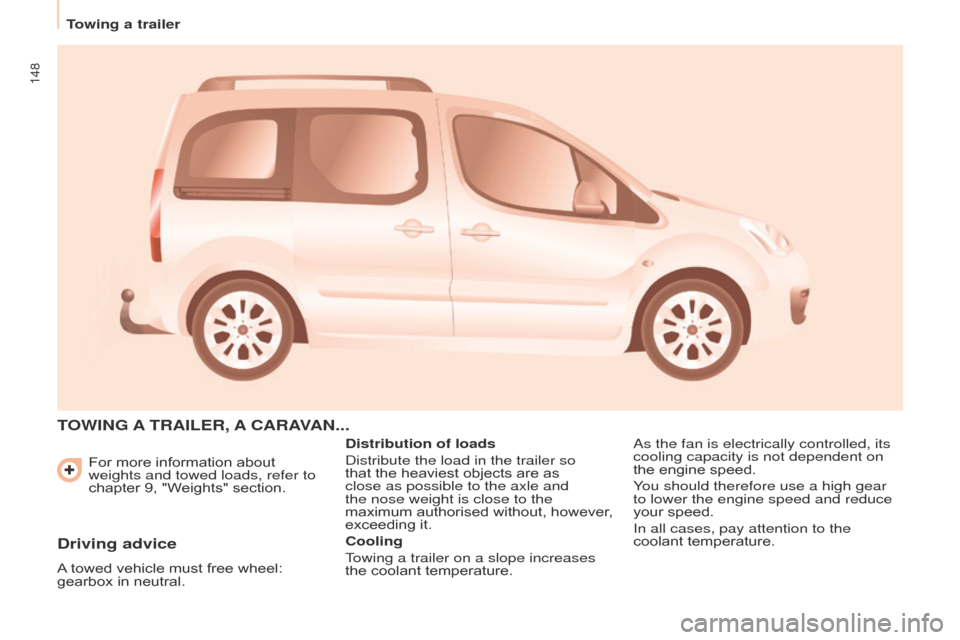
148
Towing a trailer
Berlingo-2-VP_en_Chap06_accessoire_ed01-2016
For more information about weights and towed loads, refer to
chapter 9, "Weights" section.
TOWING A TRAILER , A CARA VAN ...
Distribution of loads
d
istribute the load in the trailer so
that
the heaviest objects are as
close as possible to the axle and
the nose weight is close to the
maximum
authorised without, however,
exceeding
it.
Cooling
Towing a trailer on a slope increases
the
coolant temperature.a s the fan is electrically controlled, its
cooling capacity is not dependent on
the
engine speed.
You should therefore use a high gear
to lower the engine speed and reduce
your
speed.
In all cases, pay attention to the
coolant
temperature.
Driving advice
A towed vehicle must free wheel: gearbox
in neutral.
Page 151 of 296
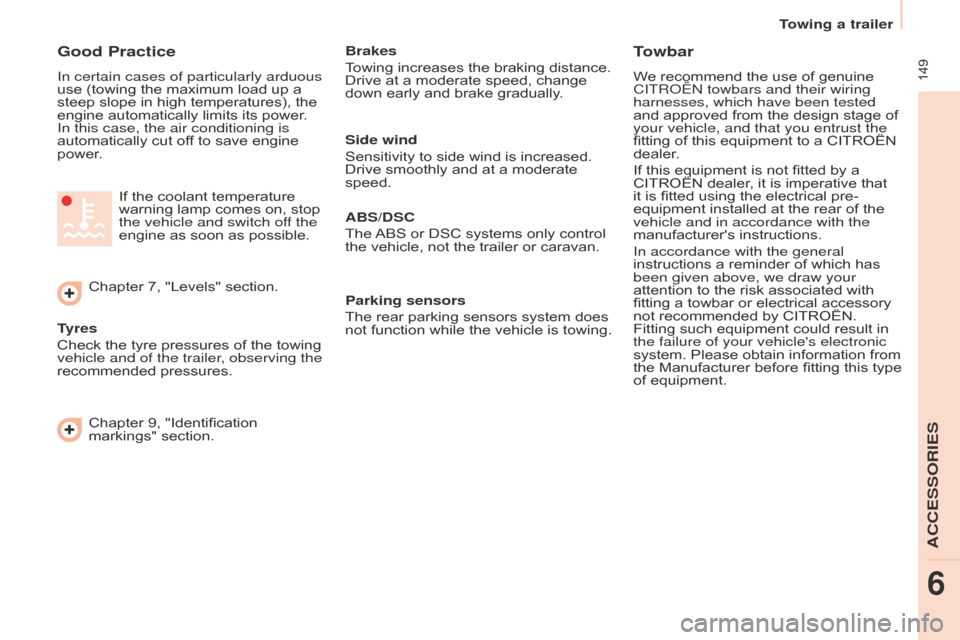
149
Towing a trailer
Berlingo-2-VP_en_Chap06_accessoire_ed01-2016
Good Practice
In certain cases of particularly arduous
use (towing the maximum load up a
steep
slope in high temperatures), the
engine
automatically limits its power.
In this case, the air conditioning is
automatically
cut off to save engine
power
.
Tyres
Check
the tyre pressures of the towing
vehicle and of the trailer
, observing the
recommended
pressures.
Chapter
7, "Levels" section.
If
the coolant temperature
warning
lamp comes on, stop
the vehicle and switch of
f the
engine
as soon as possible.Brakes
Towing
increases the braking distance. Drive
at a moderate speed, change
down
early and brake gradually.
Towbar
We recommend the use of genuine CITRo Ë n towbars and their wiring
harnesses, which have been tested
and
approved from the design stage of
your vehicle, and that you entrust the
fitting
of this equipment to a CITROËN
dealer
.
If
this equipment is not fitted by a
CITROËN
dealer, it is imperative that
it
is fitted using the electrical pre-
equipment
installed at the rear of the
vehicle and in accordance with the
manufacturer's
instructions.
In accordance with the general
instructions
a reminder of which has
been given above, we draw your
attention
to the risk associated with
fitting
a towbar or electrical accessory
not
recommended by CITROËN.
Fitting
such equipment could result in
the failure of your vehicle's electronic
system.
Please obtain information from
the
Manufacturer before fitting this type
of
equipment.
Side wind
Sensitivity
to
side
wind
is
increased.
Drive
smoothly
and
at
a
moderate
speed.
ABS/DSC
The
ABS
or
DSC
systems
only
control
the
vehicle,
not
the
trailer
or
caravan.
Parking sensors
The
rear
parking
sensors
system
does
not
function
while
the
vehicle
is
towing.
Chapter
9,
"Identification
markings"
section.
ACCESSORIES
6
Page 155 of 296

153
Berlingo-2-VP_en_Chap07_Verification_ed01-2016
Maintenance with TOTAL
TOTAL & CITROËN
Partners in performance and
protecting the environment
Innovation in the search for
performance
For over 40 year, the T
o
T
a
L Research and
Development
departments have developed
for
CITROËN, lubricants to match the latest
technical innovations on CITR
o Ë n vehicles,
both
for competition and for everyday motoring.
For you, this is an assurance that you will
obtain
of the best performance from your
engine.
Optimum protection for your
engine
By having your CITR
o Ë n
vehicle serviced with T
o
T
a
L
lubricants, you are contributing
towards
improving the life and
performance
of your engine,
while also protecting the
environment. prefers
CHECkS
7
Page 157 of 296
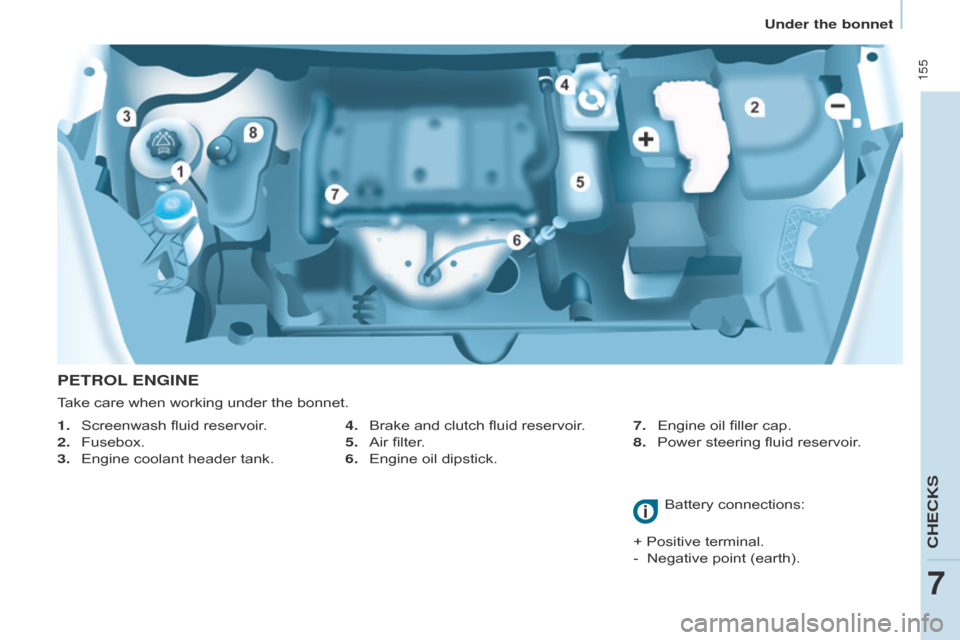
155
Berlingo-2-VP_en_Chap07_Verification_ed01-2016
Under the bonnet
PETROL ENGINE
1. Screenwash fluid reservoir.
2.
Fusebox.
3.
Engine
coolant header tank.
Battery
connections:
+
Positive terminal.
-
Negative point (earth).
Take
care when working under the bonnet.
4. Brake and clutch fluid reservoir.
5.
Air
filter.
6.
Engine
oil dipstick.7.
Engine oil filler cap.
8.
Power
steering fluid reservoir.
CHECkS
7
Page 158 of 296
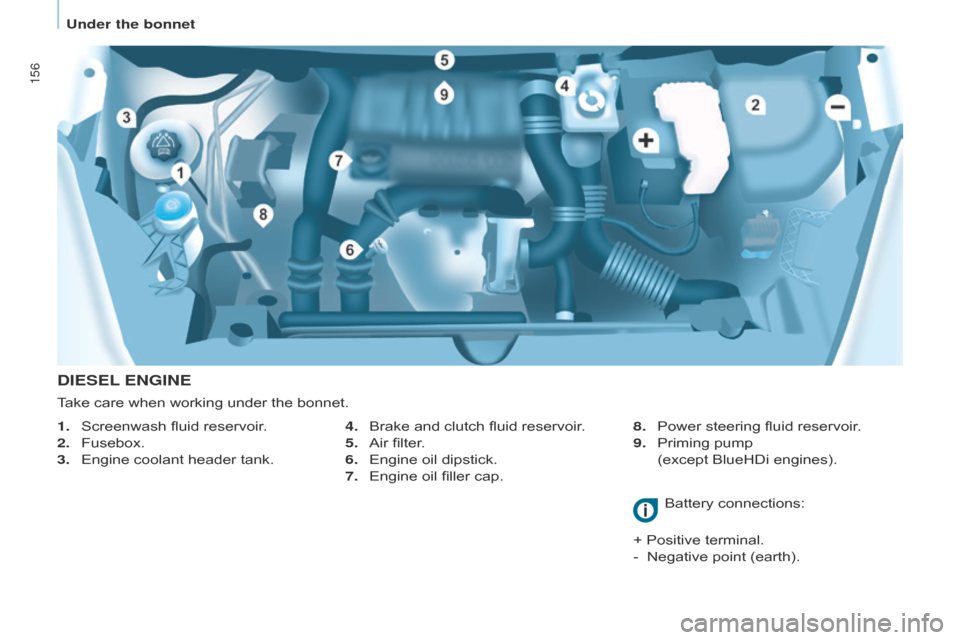
156
Berlingo-2-VP_en_Chap07_Verification_ed01-2016
Under the bonnet
DIESEL ENGINE
4. Brake and clutch fluid reservoir.
5.
Air
filter.
6.
Engine
oil dipstick.
7.
Engine
oil filler cap. 8.
Power steering fluid reservoir.
9.
Priming
pump
(except
BlueHDi engines).
1.
Screenwash
fluid
reservoir.
2.
Fusebox.
3.
Engine
coolant
header
tank.
Battery
connections:
+
Positive terminal.
-
Negative point (earth).
Take
care
when
working
under
the
bonnet.
Page 159 of 296

157
Berlingo-2-VP_en_Chap07_Verification_ed01-2016
Levels
LEVELS
Oil change
This must be carried out at the intervals specified in the
manufacturer's
servicing schedule.
Ask
for
advice from a CITROËN dealer.
Remove
the dipstick before filling.
Check
the level after filling (never
exceed
the max mark).
Refit
the oil filler cap before closing the
bonnet.
Changing the brake fluid
The brake fluid must be changed at the intervals stated, according to the
manufacturer's servicing schedule.
Use
fluids recommended by the
manufacturer
, which meet the DOT4
standard.
The
level must be between the MIN
and
MAX marks on the reservoir.
If
fluid has to be added frequently,
this
indicates a fault which must be
checked
by a CITROËN dealer or
a
qualified workshop as soon as
possible.
Warning lamps
If you have to remove / refit the engine style cover, handle it with
care
to avoid damaging the fixing
clips.
Oil level
It is recommended that the oil level be checked every 3 000 miles (5 000 km)
and topped up if necessary between oil
changes.
Check
the level with the vehicle level,
engine
cold, using the dipstick.
Dipstick
Viscosity selection
In
all cases, the oil selected must
meet
the requirements specified in the
manufacturer's
service schedule.
These
regular maintenance
operations
will keep your vehicle
in
good working order.
Ask
for
advice
from a CITROËN dealer or refer
to
the maintenance and warranty guide
in
the handbook pack.
Checks using the warning
lamps
in the instrument panel
is described in chapter 3,
"Instruments
and controls"
section.
There
are two marks on
the
dipstick:
A
= maximum
If
you fill past this mark,
contact a CITR
o Ë n
dealer
or a qualified
workshop.
B
= minimum
n
ever allow the level to
fall
below this mark.
To
maintain the reliability
of
engines and emission
control
systems, the use
of additives in engine oil
is
prohibited.
CHECKS
7
Page 160 of 296
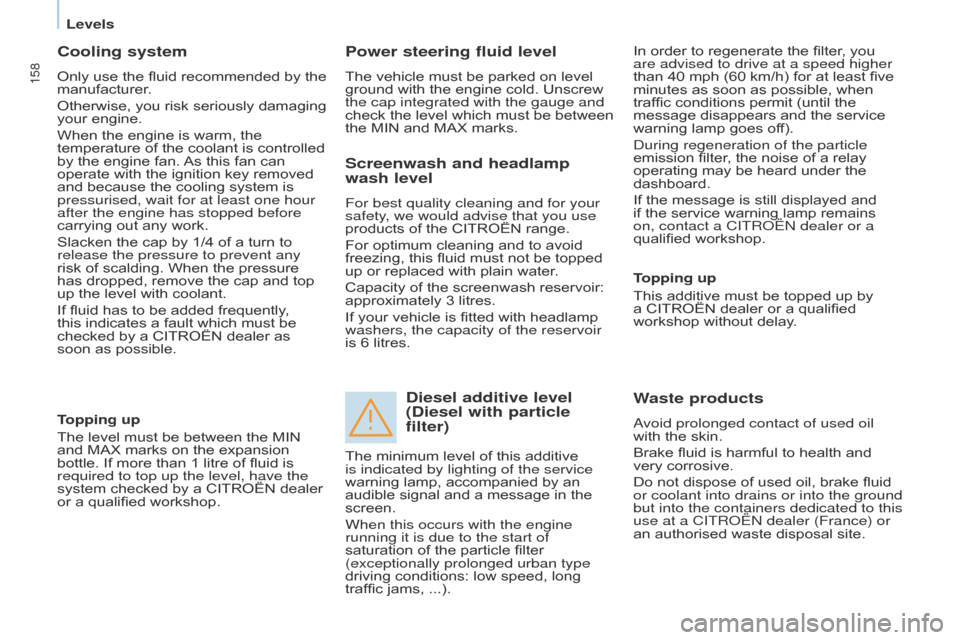
158
Berlingo-2-VP_en_Chap07_Verification_ed01-2016
Levels
Cooling system
Only use the fluid recommended by the manufacturer.
Otherwise,
you risk seriously damaging
your
engine.
When
the engine is warm, the
temperature
of the coolant is controlled
by
the engine fan.
As
this fan can
operate
with the ignition key removed
and
because the cooling system is
pressurised, wait for at least one hour
after the engine has stopped before
carrying
out any work.
Slacken
the cap by 1/4 of a turn to
release the pressure to prevent any
risk
of scalding. When the pressure
has
dropped, remove the cap and top
up
the level with coolant.
If
fluid has to be added frequently,
this
indicates a fault which must be
checked
by a CITROËN dealer as
soon
as possible.
Power steering fluid level
The vehicle must be parked on level ground with the engine cold. Unscrew
the cap integrated with the gauge and
check
the level which must be between
the
MIN and MAX marks. In
order to regenerate the filter, you are advised to drive at a speed higher
than
40 mph (60 km/h) for at least five minutes
as soon as possible, when
traffic
conditions permit (until the
message
disappears and the service
warning
lamp goes off).
d
uring regeneration of the particle
emission
filter, the noise of a relay
operating
may be heard under the
dashboard.
If
the message is still displayed and
if
the service warning lamp remains
on, contact a CITR
o Ë n dealer or a
qualified
workshop.
Topping up
The
level
must
be
between
the
MIN
and
MAX
marks
on
the
expansion
bottle.
If
more
than
1
litre
of
fluid
is
required to top up the level, have the
system
checked
by
a
CITROËN
dealer
or
a
qualified
workshop.
Screenwash and headlamp
wash level
For best quality cleaning and for your
safety, we would advise that you use
products of the CITROËN range.
For
optimum cleaning and to avoid
freezing,
this fluid must not be topped
up
or replaced with plain water.
Capacity
of the screenwash reservoir:
approximately
3 litres.
If
your vehicle is fitted with headlamp
washers, the capacity of the reservoir
is
6 litres.
Diesel additive level
(Diesel with particle
filter)
Topping up
This additive must be topped up by
a
CITROËN dealer or a qualified
workshop
without delay.
Waste products
avoid prolonged contact of used oil
with the skin.
Brake
fluid is harmful to health and
very
corrosive.
Do
not dispose of used oil, brake fluid
or coolant into drains or into the ground
but into the containers dedicated to this
use at a CITR
o Ë n dealer (France) or
an
authorised waste disposal site.
The
minimum
level
of
this
additive
is indicated by lighting of the service
warning
lamp,
accompanied
by
an
audible
signal
and
a
message
in
the
screen.
When this occurs with the engine
running it is due to the start of
saturation
of
the
particle
filter
(exceptionally prolonged urban type
driving
conditions:
low
speed,
long
traffic
jams,
...).
Page 162 of 296
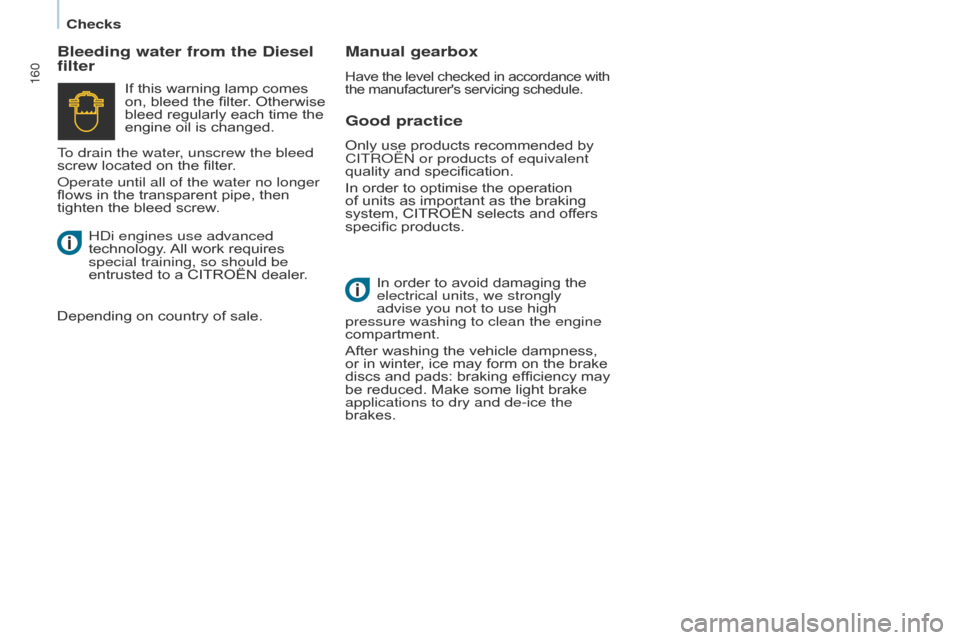
160
Berlingo-2-VP_en_Chap07_Verification_ed01-2016
Checks
Good practice
Bleeding water from the Diesel
filter
Manual gearbox
Have the level checked in accordance with the
manufacturer's servicing schedule.
In order to avoid damaging the electrical units, we strongly
advise you not to use high
pressure washing to clean the engine
compartment.
After
washing the vehicle dampness,
or
in
winter, ice may form on the brake
discs
and pads: braking efficiency may
be
reduced. Make some light brake
applications to dry and de-ice the
brakes.
If
this
warning
lamp
comes
on,
bleed
the
filter.
Otherwise
bleed
regularly
each
time
the
engine
oil
is
changed.
H
d
i engines use advanced
technology.
All
work
requires
special training, so should be
entrusted
to
a
CITROËN
dealer.
Depending
on
country
of
sale.
To drain the water, unscrew the bleed
screw
located
on
the
filter.
o
perate until all of the water no longer
flows
in
the
transparent
pipe,
then
tighten
the
bleed
screw.
Only use products recommended by
CITR
o Ë n or products of equivalent
quality and specification.
In
order to optimise the operation
of
units as important as the braking
system,
CITROËN selects and offers
specific
products.
Page 163 of 296
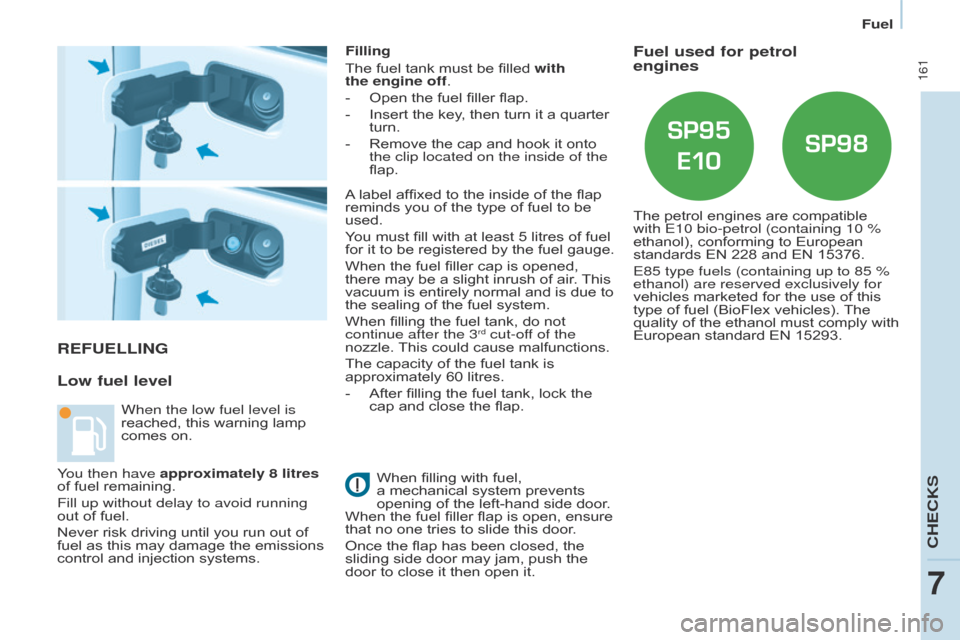
161
Berlingo-2-VP_en_Chap07_Verification_ed01-2016
Fuel
REFUELLING
Low fuel level
Filling
The fuel tank must be filled with
the
engine off.
-
Open
the fuel filler flap.
-
Insert
the key, then turn it a quarter
turn.
-
Remove
the cap and hook it onto
the clip located on the inside of the
flap.
When
filling with fuel,
a mechanical
system prevents
opening
of the left-hand side door.
When
the fuel filler flap is open, ensure
that
no one tries to slide this door.
Once
the flap has been closed, the
sliding
side door may jam, push the
door
to close it then open it.
When the low fuel level is
reached,
this
warning
lamp
comes
on. A
label affixed to the inside of the flap
reminds
you of the type of fuel to be
used.
Y
ou must fill with at least 5 litres of fuel
for
it to be registered by the fuel gauge.
When
the fuel filler cap is opened,
there
may be a slight inrush of air.
This
vacuum
is entirely normal and is due to
the
sealing of the fuel system.
When
filling the fuel tank, do not
continue after the 3rd cut-off of the
nozzle.
This
could
cause malfunctions.
The
capacity
of
the
fuel tank is
approximately
60
litres.
-
After
filling
the
fuel tank, lock the
cap
and
close
the flap.
Fuel used for petrol
engines
The petrol engines are compatible with E10 bio-petrol (containing 10 %
ethanol), conforming to European
standards
EN 228 and EN 15376.
E85 type fuels (containing up to 85 %
ethanol) are reserved exclusively for
vehicles
marketed for the use of this
type
of fuel (BioFlex vehicles).
The
quality
of the ethanol must comply with
European
standard EN 15293.
You then have approximately 8 litres
of
fuel
remaining.
Fill up without delay to avoid running
out
of
fuel.
Never
risk
driving
until
you
run
out
of
fuel
as
this
may
damage
the
emissions
control
and
injection
systems.
CHECkS
7
Page 164 of 296
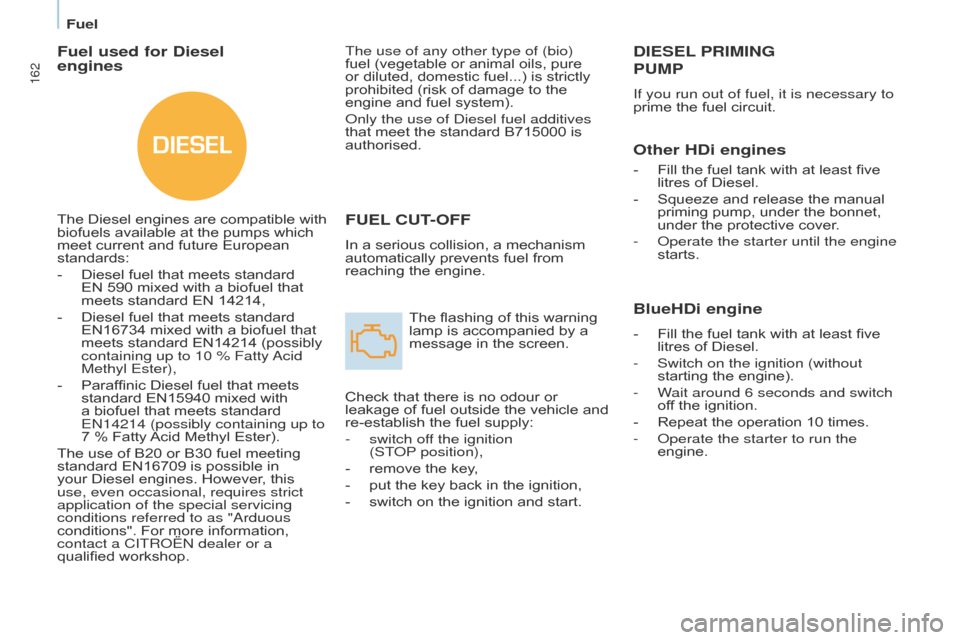
DIESEL
162
Berlingo-2-VP_en_Chap07_Verification_ed01-2016
Fuel
FUEL CUT- OFF
In a serious collision, a mechanism automatically
prevents fuel from
reaching
the engine.
The
flashing of this warning
lamp
is accompanied by a
message
in the screen.
Check
that there is no odour or
leakage
of fuel outside the vehicle and
re-establish
the fuel supply:
-
switch of
f the ignition
(ST
o
P
position),
-
remove
the key,
-
put
the key back in the ignition,
-
switch
on the ignition and start.
DIESEL PRIMING
PUMP
Fuel used for Diesel
engines
The Diesel engines are compatible with biofuels
available at the pumps which
meet
current and future European
standards:
-
Diesel
fuel that meets standard
EN 590
mixed with a biofuel that
meets
standard EN 14214,
-
Diesel
fuel that meets standard
EN16734
mixed with a biofuel that
meets
standard EN14214 (possibly
containing up to 10 % Fatty a
cid
Methyl Ester),
-
Paraffinic
Diesel fuel that meets
standard
EN15940 mixed with
a
biofuel that meets standard
E
n 14214 (possibly containing up to
7
% Fatty
Acid
Methyl Ester).
The
use of B20 or B30 fuel meeting
standard
EN16709 is possible in
your
Diesel engines. However, this
use, even occasional, requires strict
application of the special servicing
conditions referred to as "
a rduous
conditions".
For more information,
contact a CITR
o Ë n dealer or a
qualified
workshop. If you run out of fuel, it is necessary to
prime
the fuel circuit.
Other HDi engines
- Fill
the fuel tank with at least five litres
of Diesel.
-
Squeeze
and release the manual
priming
pump, under the bonnet,
under
the protective cover.
-
o perate the starter until the engine
starts.
BlueHDi engine
- Fill the fuel tank with at least five litres
of Diesel.
-
Switch on the ignition (without
starting
the engine).
-
W
ait around 6 seconds and switch
off
the ignition.
-
Repeat
the operation 10 times.
-
o perate the starter to run the
engine.
The use of any other type of (bio)
fuel
(vegetable
or
animal
oils,
pure
or
diluted,
domestic
fuel...)
is
strictly
prohibited
(risk
of
damage
to
the
engine
and
fuel
system).
o
nly the use of
d
iesel fuel additives
that
meet
the
standard
B715000
is
authorised.